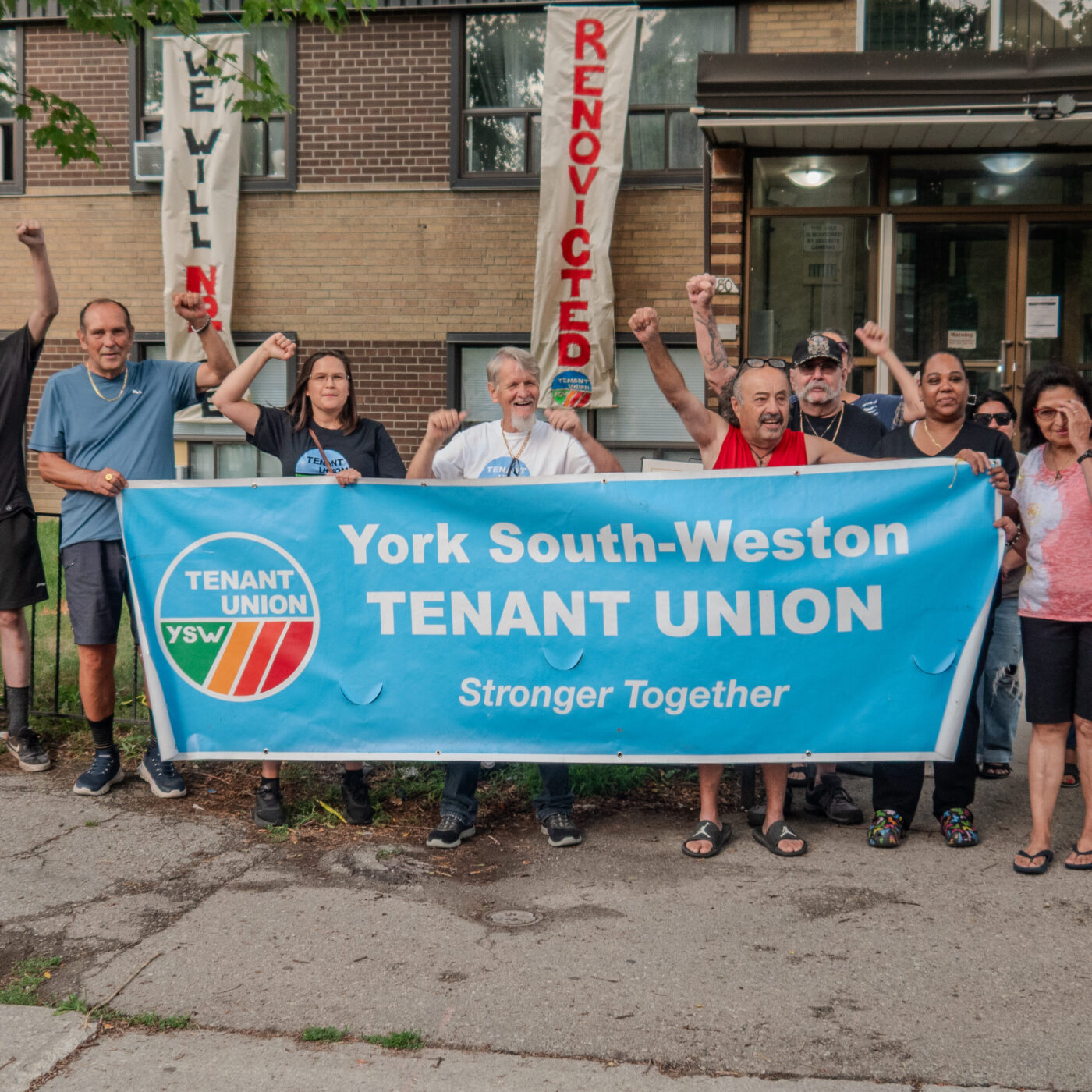THE GREEN LINE GUIDE TO...
FIGHTING ABOVE GUIDELINE RENT INCREASES

York South-Weston Tenant Union member and 33 King St. tenant, Sharlene Henry, marches in Enough is Enough Day of Action near Nathan Phillips Square on June 3, 2023.

WITH Sharlene Henry

James Westman
Humber journalism graduate. Existential threat observer. Explored every park and trail in Toronto, with a map to prove it. Believes the Leslie Street Spit is the city's best hidden gem.
Sept. 16, 2024
Sharlene Henry lives at 33 King St. in Weston.
She has fought multiple above guideline rent increases (AGIs) and, through the process, helped form the 33 King St. tenants’ association and eventually the York South-Weston Tenant Union.
When Henry’s three-year-old son asked why she and her husband worked so much she said they were working to buy a house. Her son then asked what was wrong with the apartment they lived in, and described everything he loved about the neighbourhood: abundant parks, his grandmother living in the building, the community centre and the Humber River Recreational Trail. Henry said this helped her see her building through a child’s eyes — to her son, their apartment was more than a rented unit. It was home.
Around this time, the home that her son was so fond of came under threat by an uptick in AGIs for the the tenants of 33 King St.
“These rent increases started coming because ownership had changed hands. We had had regular rent increases for many years, [but] some years, nothing. That's probably when the landlord knew he wanted out,” Henry explains.
“We had this meeting with the FMTA in our lobby telling us, ‘You know, you got this AGI thing. We're all like, ‘What's an AGI?’ Nobody knew what it was in the building, [so we started] really learning about how the process works…and we started to try to mobilize ourselves and fight this increase.”
In an interview with The Green Line, Henry described how she and her neighbours organized a rent strike against multiple AGIs in her building. The steps Henry and her neighbours took have been summarized in checklist form as a tool for tenants to navigate how to potentially decrease AGIs they feel are unfair. Henry was consulted on the checklist via interviews and feedback.
Part One: connect with your community
1. Talk to your immediate neighbours to get more information.
- If you live in an apartment building, door-knock your floor; ask: Did you also get the rent increase notice?
- If they’ve lived there longer than you, ask: Have you received an AGI before?
- Henry’s take: “Start up conversations about, ‘You know, I Googled this and we could go to court and — if we go together — kind of fight this and see what happens and maybe not win it all,’ But I would knock on my neighbour’s doors because that's how I got involved.”
2. Door-knock your building to see how many neighbours want to fight the rent increase
3. Ask FMTA to help you interpret and better understand your AGI notice, as well as how you can work with your neighbours to get it reduced.
- Please note that the FMTA cannot give legal advice. If you have any questions about the law, call your local legal aid clinic.
4. Seek out legal advice (and consider contacting Community Justice Collective for free legal services)
- Henry’s take: “Any legal advice you can seek out for free [is helpful’ because there are a lot of clinics that are doing this type of work. You can book an appointment and say, ‘Hey, this is happening. What can we do?’”“For the rent strike and our AGI…we have Community Justice Collective, which is a team of lawyers here in Toronto who are activists themselves and believe in what we're fighting for. So, it's of no cost to us, which is great. [The price] shocks a lot of the tenants [who] are like, ‘What? It's not costing us anything?’ I'm like, ‘No, they fundraise to raise money to do this important work.’”
5. Ask FMTA to facilitate a meeting in your building to inform tenants about their rights.
- If your building doesn’t have a tenant’s association, ask the FMTA for information on how to form one.
- Set a weekly, bi-weekly or monthly meeting time for your tenant association to meet
- Consult with your tenant association on the best way to meet: online, in person or both. In person is generally better for communication and accessibility. If meeting in person, pick a space for your tenant association to meet. Remember that tenants have the right to meet in common spaces in the building.
- Henry’s take: “It's not even having a meeting every week. Make a WhatsApp group, have a couple Zooms. You can go for 40 minutes for free. My cousin's like, ‘Really?’ I'm like, ‘You go 40 minutes for free. Girl, you hang up and you call back again if the meeting goes over.’”
part two: build your case with your neighbours
6. Collect evidence in your building if you feel the AGI is unjustified.
- For example, if your landlord isn’t getting repairs requested by tenants done on time, the AGI may not be justified. Document how long it takes for repairs to be completed via paper forms, emails, photos, videos, etc.
- Henry’s take: One of the biggest rent increases at 33 King St. was about improving the parking garage. “When you look at the parking garage pictures — because I would always take pictures — it doesn't look any different. Okay, you power washed it. Big deal, but what have you really done? And I would take pictures of the men working. I take pictures of them parked in our parking spots when they're not supposed to.” Henry adds that it's helpful to narrate videos describing who you are, what floor you're on, what day it is and other details, as settling the AGI process may take years and you yourself may forget.
7. Keep all notices (of any kind, but especially building-maintenance timelines) given to you by your landlord.
- Henry’s take: “No project finishes on time. I don't care what they say; no project finishes on time….Keep all notices — all of them. It's a tedious task, but keep all of them because those are also part of your evidence as far as we were given this notice for this [timeline of disruptive maintenance]. The one thing I've noticed now is they'll give the notice months in advance because they know that we're on top of them.”
8. Collect affidavits from tenants, especially long-term ones, who have seen the landlord fail to uphold promises involving repairs.
- Back up electronic evidence, and store in a safe place (e.g. cloud storage)
- Henry’s take: “We learned the hard way; we have to have a whole lot of evidence. So, anything that happens in the building now, there's always someone documenting it in this building — photos, videos and emails. Right now, we have one elevator out of service, but four people told me they're taking videos daily.”
9. Follow up any in-person conversation with your landlord about the AGI (or repair request) with an email.
- Henry’s take: “You follow up with an email: ‘I spoke to you on this day and this time about the water, and you affirmed to me that the water would be done. And it's that day and time, and the water's not back.’ All of that is evidence.”
part three: campaign for affordability
10. Write a petition with your tenant association, and circulate it to everyone in your building
- Circulate the petition to people in your wider community outside of the building.
11. Place non-flammable signs on your balcony to protest the AGI. Review your lease to see if this is prohibited, and consult with FMTA or a legal aid clinic if your landlord asks you to remove the signs.
12. As a tenant association, contact your city councillor, MP and MP about the AGI, and try to schedule a meeting.
13. As a tenant association, organize rallies outside of your building, and ask FMTA for help if you’ve never done this before.
- Henry’s take: “It's not just about fighting the landlord. It's about us getting together and celebrating, having ice cream together, creating a community within a community. People will listen. And that's what we did. We fight, we fight, but we party, too.”
14. Consider a rent strike to send a stronger message to your landlord, increase public pressure on them to reduce the increase and gain public support. If you move forward, set a goal for the proportion of the building you want to participate in the strike.
- Henry’s take: “We need to get half the building to do it. That was the goal at the beginning…if we're going to do something like this, it can't just be a few people. It has to be half of the building to commit to withholding. We want to hit them financially — to withhold their rent.”
15. Educate fellow tenants on the legality of rent strikes and ensure everyone knows their tenant rights. There’s a chance the landlord will send notices that sound threatening and demand a halt to tenant organizing.
16. Take periodic surveys of fellow striking tenants to see what proportion of strikers have managed to keep all of their rent money set aside. It's important to know strikers are able to pay all rent owed when the strike ends.
17. Remember that you don’t have to pay the increase on rent until it’s been approved by the Landlord and Tenant Board. Consider whether it’s better to pay the increase up front and get the money back if you win a decrease, or set the money aside to withhold the increase from your landlord until the amount has been determined and approved.
18. After negotiating with your landlord, ask your landlord for a ledger of the rent increase(s).
- Ask your neighbours or tenant association for help understanding the ledger in terms of what you may owe or what your landlord may owe you if you’ve been paying the increase, and it was reduced.
- If you’re owed a credit from your landlord, talk to your neighbours to see if they’re owed, too; do your own math to ensure your landlord has given you an accurate ledger.
19. Remember that getting an AGI down to zero is extremely difficult, and that any decrease is a win for you and your neighbours.
- Henry’s take: “It's really hard when you still see a percentage [increase] because you want to win; you don't feel you're winning. But we are winning because we've saved the people in the building millions of dollars over time.”
To make things easier, The Green Line made a printable two-page checklist, which will help you fight above-guideline rent increases in Toronto in an easy step-by-step process that escalates actions over time. Check it out below!
Fact-Check Yourself
Sources and
further reading
Don't take our word for it —
check our sources for yourself.



